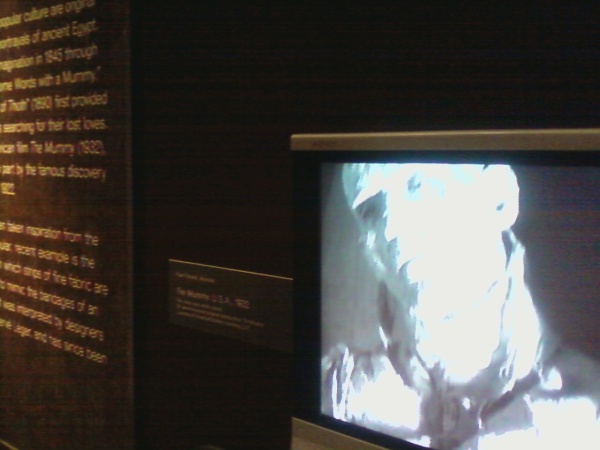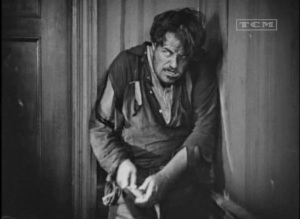
When I took my daughter to the Brooklyn Museum last Sunday and asked her what she wanted to see, she told me right away. “Mummies.”
This both was and was not a surprise. After years of fleeing the room whenever something “scary” is on TV, my daughter—at the age of eleven—has started to take a personal interest in scary things. Her favorite books changed from ‘Henry and Mudge’ to R.L. Stein, and every Wednesday night she now plants herself on the couch next to me with a bowl of popcorn to watch ‘Ghost Hunters.’ At first I was egocentric enough to believe she was humoring me, knowing that her daddy writes “scary stories” and loves “scary movies.” Now I think it’s something more.
We enter the Brooklyn Museum’s Egyptian exhibit—one of the finest in the world—and almost immediately, my daughter begins explaining the exhibits to me. This temple guardian, she says, must be Sumerian because of the way his beard is styled. (In the ancient Middle East, as in modern Middle School, hairstyle is important.)
I see my daughter four days a week. Under these circumstances, being fully present becomes a serious thing. The usual haze of self-absorption I move around in every day becomes the enemy and as we walk through these rooms together studying the ancient statues and carvings, I’m also studying her.
She explains the hieroglyphics to me. This one, the one that looks like a bowl, is the letter C. This one, the one that looks like a hawk, is an A.
I follow my daughter as she hurries from room to room, looking about appreciatively but impatiently. “Daddy, where are the mummies?” she asks. At that moment I remember—the Brooklyn Museum has no mummies. Never has, and I start to explain, reluctant to disappoint her. As I start to speak, she says, “Here they are!” and rushes into a darkened room ahead of us.
The sign above the door says THE MUMMY CHAMBER. How did I miss this? A closer look and I realize it’s a new exhibit, one I’ve never seen before.
The darkness, in contrast to the other brightly lit exhibit rooms, feels deliberate and solemn, a feeling that makes sense. The dead are here.
 When we are younger, we are drawn to mummies and their tombs, etc. because they remind us of exotic adventures and old movies, of Boris Karloff or Lon Chaney, Jr. (Imhotep or Kharis—take your pick.) Later, when we are old enough to look at mummies and see what they really are and what they mean, we may have a very different sort of reaction.
When we are younger, we are drawn to mummies and their tombs, etc. because they remind us of exotic adventures and old movies, of Boris Karloff or Lon Chaney, Jr. (Imhotep or Kharis—take your pick.) Later, when we are old enough to look at mummies and see what they really are and what they mean, we may have a very different sort of reaction.
The darkness in here feels red, like the inside of an eyelid with a great light burning on the other side. That, I can’t help but feel, is something these ancient Egyptians would have understood.
There are four mummies here. A princess. Two priests. And what the exhibit refers to as “An Anonymous Man.” It’s this “Anonymous Man” whose name, occupation, or place in history we do not know who most of all makes me feel like we’re intruding on something private and sacred.
My daughter is disappointed that the mummies are not unwrapped. She wants to see their faces. In this place and at this moment, that seems not especially horrifying, but like a transgression. The curators seem to have felt this too. The only visible concession to morbid/scientific curiosity—CT-scan images revealing the ghostly outlines of preserved flesh and bone—are, remarkably, as small as playing cards and mounted inconspicuously at knee-level as if the people who put this exhibit together are slightly ashamed by them.
+
No one knows what happens after you die. That’s a statement that people either find comforting or terrifying, depending—as so much else does—on the state of mind with which you receive it.
Some people do claim to know what happens after death, and their answer is nothing. Death, according to them, is extinction, pure and simple, like turning off a light switch. For proof, they point to the cold, hard facts of biology, the cessation of metabolic functions—brainwaves, heartbeat, etc. We are not conscious of anything after death, they say, because our consciousness ceases. And that is precisely where their argument breaks down. Because here is one more cold hard fact; no one knows what consciousness is.
Some people say that just because science can’t provide an explanation for everything, that doesn’t mean you are free to make up whatever fantastic story you wish. Actually, that is exactly what we are all free to do. And the value of the particular story you believe may not depend on whether or not it is true (which you may never know anyway) but whether or not it is useful.
This is not an idea that sits well with the scientifically minded. It is not the job of science, they say, to prove that heaven does not exist. Fair enough. However, unlike heaven, pretty much everyone agrees that consciousness does exist, and to claim without proof that consciousness ceases simply because it appears to cease may not be that different than claiming the sun is extinguished forever when we see it set in the West. Even the ancient Egyptians knew better than that.
+
 I follow my daughter through the darkness, looking for more mummies. As we pass from one room into the next, I glance to my left and see a long, brightly lit passageway hidden between the two larger chambers. Against the wall there is a long, glass case containing an ancient scroll, the longest I’ve ever seen. The sign tells me this is The Book of the Dead of the Goldworker of Amun, Sobekmose, and that it contains the spells needed to bring the dead back to life for the journey to the afterlife. I stop to read the translations posted on the wall.
I follow my daughter through the darkness, looking for more mummies. As we pass from one room into the next, I glance to my left and see a long, brightly lit passageway hidden between the two larger chambers. Against the wall there is a long, glass case containing an ancient scroll, the longest I’ve ever seen. The sign tells me this is The Book of the Dead of the Goldworker of Amun, Sobekmose, and that it contains the spells needed to bring the dead back to life for the journey to the afterlife. I stop to read the translations posted on the wall.
Earlier, my daughter had explained to me that mummies have all of their internal organs removed, except for one—the heart. For the dead to return to life and begin their journey through the afterlife, the first thing that must be revived is the heart. And it’s with the heart that the scroll begins.
SPELL FOR GIVING THE HEART TO THE GOLDWORKER OF AMUN, SOBEKMOSE, JUSTIFIED IN THE NECROPOLIS.
O HEART THAT IS IN THE HOUSE OF HEARTS, O HEART THAT IS IN THE HOUSE OF HEARTS, I HAVE MY HEART AND IT IS PLEASED.
These are the first words I’ve ever read from the Egyptian Book of the Dead. Everything else around me seems to fall away, and I stand there reading for a long time.
If you grow up learning about all the worldly things the Egyptians brought with them into the tomb—food, drink, money, books, tools, toys, chariots, even their pets—it’s easy to think of them as suffering from a massive and deluded sense of materialistic entitlement, like rich people who insist on dragging too much luggage on board cruise ships or airlines.
But that’s not the voice I hear speaking in these words in front of me. It’s not the voice of a crass, smug, consumerist mentality toward the afterlife This voice is not boastful—instead, it feels devout, earnest, and most of all, radically and overwhelmingly naked and alone.
BEHOLD ME, I AM COME. I HAVE BROUGHT TRUTH TO YOU. I HAVE REPRESSED WRONGDOING FOR YOU. I HAVE NOT DONE WRONG AGAINST ANYONE. I HAVE NOT IMPOVERISHED MY ASSOCIATES. I HAVE NOT DONE EVIL IN PLACE OF TRUTH. I HAVE NOT KNOWN THAT WHICH SHOULD NOT BE. I HAVE NOT DONE ANYTHING BAD.
I have not done anything bad. How to hear those words? How to even begin to say them?
We all say things we’re not really certain of in order to make them true. I’m trying as hard as I can. I am lucky to be alive. Everything will be alright. I am a good father.
I AM COME BEFORE YOU. NO SIN OF MINE EXISTS. NO DISPLEASURE OF MINE EXISTS. NO EVIL OF MINE EXISTS. NO WITNESSES AGAINST ME EXIST. THERE IS NO ONE AGAINST WHOM I HAVE DONE THINGS. I LIVE ON TRUTH. I SWALLOW DOWN TRUTH.
We say or think these things in order to carve out a space in the darkness around us so we can move and breathe again, a space where we can change. And the harder it is to believe, the bigger and stronger our words need to be.
For a modern society that mostly no longer believes in an afterlife, a whole culture devoting itself to preparing for it may seem like a colossal and tragic waste of time. But looking at the words on these walls, I start to feel that what these people were preparing for was not some mysterious future world but this one.
In Kadampa Buddhism it’s said that we don’t need to be afraid of death—what we should be afraid of is dying with an uncontrolled mind. Because that is something we can do something about.
Remembering this, I look around at the words on this scroll and the hundreds of statues, carvings, and objects around us, and I start to think of them not as a people’s deluded and pathetic attempt to control death, but as an imaginative and heroic effort to control their own minds.
+
When my father was in the hospital dying, the moment my sister and I were both in the room with him, he drew us both to his side—me on his left, my sister on his right—and held on tightly to our hands. The feeling of relief and gratitude that came radiating off of him at that moment was nearly blinding. We were his, and in that moment he had what was his. I wondered if he wanted to take us with him. If I’d known how, I think I would have done it.
You can’t take it with you, they say. But what if you could? What would you take?
First you think, Take only what is most precious. Only what is absolutely necessary. Then you think, How can I leave this behind? Or this? Or this? Until, in the end, you see that what is precious, what is absolutely necessary is everything.
I look over and see my daughter taking pictures of the scroll and of the words on the wall, the same words I’ve been reading for a while now. She’s been reading them too, silently, and now she reads them aloud, her young voice echoing softly in the dark:
O HEART THAT IS IN THE HOUSE OF HEARTS, O HEART THAT IS IN THE HOUSE OF HEARTS, I HAVE MY HEART AND IT IS PLEASED.

We are finished here for today. My daughter and I are both silent as we leave the museum. Walking beside her, I see how tall she’s grown. I’m hoping she’ll let me hold her hand, and on the way down the big marble steps, she does.
Out here the sun feels bright but not too bright—looking up I see that it has already set. There is a hollowed-out space inside my chest, but it does not feel empty. Not entirely.
For all the things I don’t know yet (and they are many), I do know this—we need to wake up. And we need the things around us to wake us up. Whether it’s the bare branches of the tree outside my window against the morning sky, or watching my young daughter’s fingers trace the words on a 3,000 year-old parchment and then slip into my hand—in these things and through these things, I have my heart. I have my heart and it is pleased.























